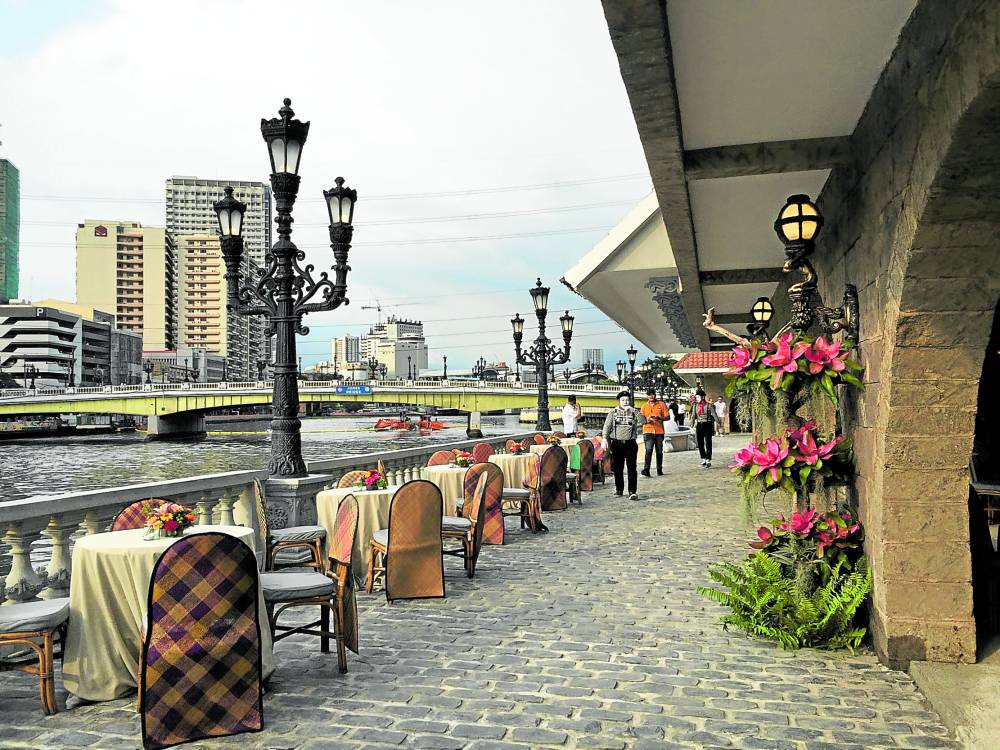
The latest phase of the Pasig River Urban Development Project, referred to as the Pasig River Esplanade, part of the government’s program “Pasig, Bigyang Buhay Muli,” was recently inaugurated and opened to the public, a day before the 453rd founding anniversary of Manila.
This section, opened six months after the first two subphases were inaugurated in January, starts from Jones Bridge to Plaza Mexico and features ornate lamp posts, leasable stalls and a one-story structure with a roof deck.
With the work on its extension to Fort Santiago underway, the esplanade, which has walkways, bike lanes and boardwalk and is adorned with decorative balusters on the railings, is expected to be completed in three years.
The opened section plus the one opened in January and the area under construction going to Plaza Mexico will complete the 500-meter showcase area of the project, seen to improve pedestrianization, mobility and heritage appreciation of the area.In his speech during the event, President Ferdinand Marcos Jr. said the project will “add vibrance and drive tourism and generate tourism activity along the riverbanks,” in line with the national agenda of sustainable development, benefiting generations to come.
“The structures within the project are also targeted to use renewable energy and promote other ecological practices that are aligned with our environmental protection and conservation strategies,” he added. “After decades of neglect, let us witness the revitalization of our beloved Pasig River.”
Marcos compared the river to other famed waterways in the world such as the Chao Phraya River in Thailand, Seine in France and Thames in England. “But the Pasig River, unlike any other, has ‘its own stories, its own lessons and its heritage to tell,’” he said.
The river also “holds immense historical and cultural significance, as a vital waterway which facilitates trade, transportation and communication, and serves as a prominent landmark and tourist attraction,” the President pointed out.River council
The project began on July 23, 2023, when Marcos signed Executive Order (EO) No. 35 constituting the Inter-Agency Council for the Pasig River Urban Development, which was mandated to rehabilitate the river.
The council technically replaces the Pasig River Rehabilitation Commission created in 1999 through an EO and de-established in 2019, also through an EO.
The new council is composed of the Department of Human Settlements and Urban Development (DHSUD), with its secretary serving as the chair, and the Metro Manila Development Authority, whose chief serves as its vice chair. The other members include the heads of the Departments of Public Works and Highways; Environment and Natural Resources; Interior and Local Government; Tourism; Transportation; Finance; and Budget and Management, as well as the chairs of the National Commission for Culture and the Arts; National Historical Commission of the Philippines; Philippine Ports Authority general manager; Philippine Coast Guard commandant; Laguna Lake Development Authority general manager; and chief executive officer of the Tourism Infrastructure and Enterprise Zone Authority.
Its secretariat is the National Housing Authority.
Some of the roles of the council include crafting the development plan for the river and related areas for purposes such as tourism and sustainable human settlement; providing easements on the river and other waterways connected to it; and the relocation of informal settlers along its riverbanks.
Master plan
Famed landscape architect Paulo Alcazaren said he was initially consulted for the esplanade and conceptual framework of the project, leading to the master plan by his urban design and landscape architectural firm PGAA with William Ti of WTA.
The master plan includes nine sections of the entire length of the Pasig River and involves the construction of a linear park along the 26-km stretch of the river.
“The implementation and actual detailed design of the sections that have been completed was done by a technical group under DHSUD and overseen directly by Secretary (Jerry) Acuzar,” said the architect, who designed the award-winning Iloilo Esplanade.
Following the recent announcement of San Miguel Corp.’s Ramon Ang that the Pasig River Expressway (Parex) project is still in the offing, this “would negate all of the improvements that the Pasig Esplanade and the larger Pasig urban redevelopment would bring,” said Alcazaren.
“It would compromise heritage structures and sites, increase environmental degradation, add to noise pollution and visual blight, and property values would decrease,” he added.
Skyways, warned Alcazaren, will not solve traffic congestion, since traffic builds up at the on and off ramps of expressways.
“Because of the principle of induced demand, more cars will enter the system,” he said, adding that “countless cities around the world are demolishing such infrastructure and bringing back parks on open space.”
The esplanade project has also attracted its share of criticism, with the number of lamp posts described as “overkill.” The relief of angels on phases 1A and 1B were also criticized for having breasts, abs, and disproportionate anatomy.
These are no longer present in the recently opened phase.
However, the elevated portion of the project’s latest phase also obscures the view of the river and the heritage buildings along Muelle de la Industria in Binondo to the commuting and driving public who pass through Riverside Drive.